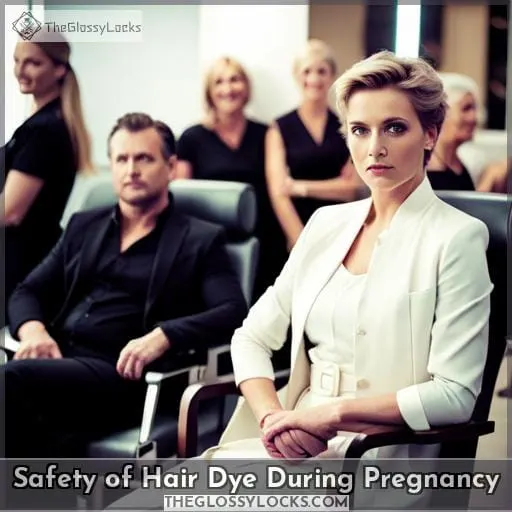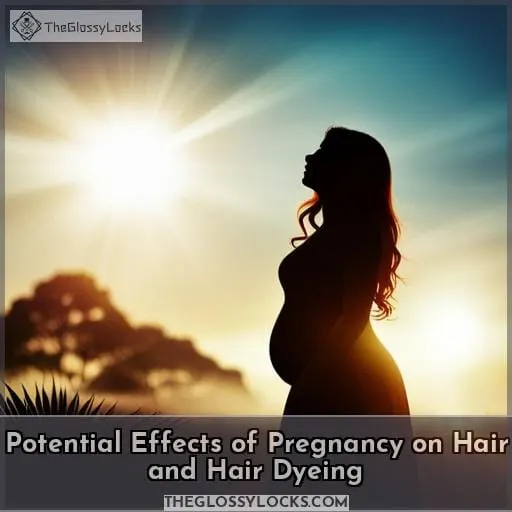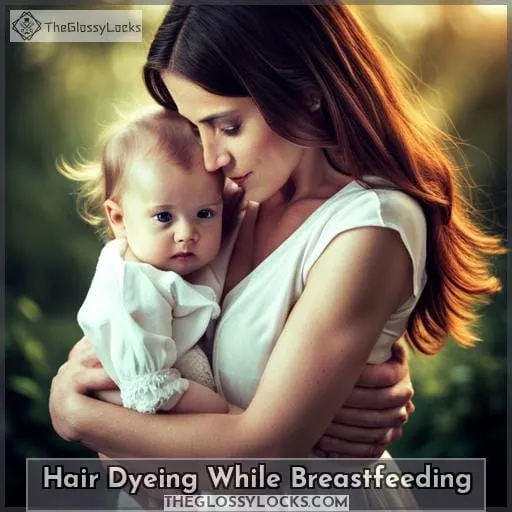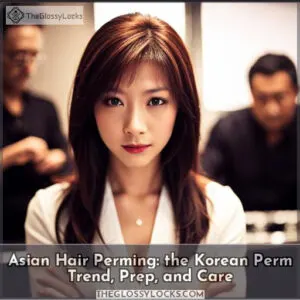This site is supported by our readers. We may earn a commission, at no cost to you, if you purchase through links.
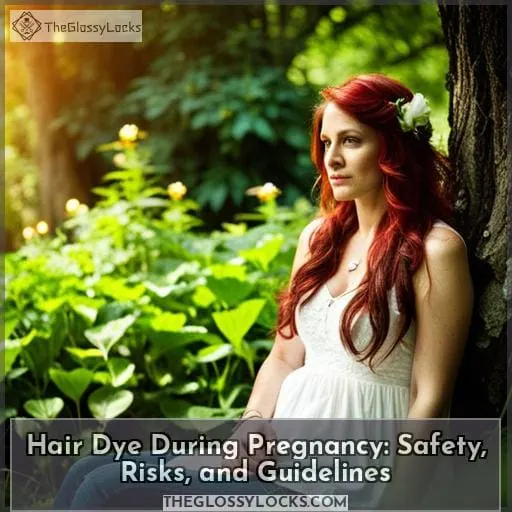 Imagine the feeling of freedom and self-expression that comes with dyeing your hair. But now, as a pregnant woman, you may be wondering if it’s safe to continue this ritual.
Imagine the feeling of freedom and self-expression that comes with dyeing your hair. But now, as a pregnant woman, you may be wondering if it’s safe to continue this ritual.
The safety of hair dye during pregnancy is a topic surrounded by mixed opinions and limited research.
In this article, we will explore the safety guidelines and potential risks associated with using hair dye while pregnant so that you can make an informed decision for yourself and your baby.
Table Of Contents
- Key Takeaways
- Safety of Hair Dye During Pregnancy
- Precautions and Guidelines for Using Hair Dye During Pregnancy
- Potential Effects of Pregnancy on Hair and Hair Dyeing
- Hair Dyeing While Breastfeeding
- Educating Yourself and Making Informed Decisions
- Frequently Asked Questions (FAQs)
- Can using hair dye during pregnancy increase the risk of birth defects?
- Are there any specific hair dye brands that are considered safe to use during pregnancy?
- Can the chemicals in hair dye be absorbed through the skin and harm the developing fetus?
- Is it safer to use permanent or semi-permanent hair dye during pregnancy?
- Are there any natural or organic hair dye alternatives that are recommended for pregnant women?
- Conclusion
Key Takeaways
- Limited research on the effects of hair dye during pregnancy
- Importance of consulting with healthcare providers for personalized guidance
- Consideration of safer alternatives and precautions during dyeing
- Limited transfer of chemicals to breast milk during breastfeeding
Safety of Hair Dye During Pregnancy
When it comes to the safety of using hair dye during pregnancy, there’s limited research available. It’s important to consider potential risks and concerns associated with hair dye chemicals while pregnant.
Taking a cautious approach and following recommended guidelines can help minimize any potential harm.
A. Limited Research on Hair Dye Effects During Pregnancy
There is limited research on the effects of hair dye during pregnancy. Due to ethical concerns, pregnant participants are often excluded from studies, making it challenging to obtain conclusive evidence.
This lack of research poses challenges in determining the safety guidelines for hair dye use during pregnancy and assessing potential risks.
It’s essential for expectant mothers to make informed decisions with the limited evidence available and seek advice from healthcare professionals or hairdressers regarding any possible risks associated with chemical absorption.
B. Potential Risks and Concerns
When considering the safety of hair dye during pregnancy, it’s important to address potential risks and concerns related to its use.
Animal studies have shown mixed results regarding the effects of hair dye on pregnancy outcomes.
While some experts believe that limited chemical absorption through the scalp poses minimal risk, others suggest exploring safer alternatives or waiting until the second trimester for dyeing hair.
Breastfeeding safety should also be taken into consideration when using hair dye during pregnancy.
Precautions and Guidelines for Using Hair Dye During Pregnancy
When using hair dye during pregnancy, it’s important to take certain precautions and follow guidelines to minimize potential risks.
First and foremost, consult with your healthcare provider before proceeding with any hair coloring.
Timing considerations are also crucial – it’s advisable to wait until after the first trimester when the risk is lower.
Additionally, perform a patch test on a small area of skin before full application to check for any adverse reactions or skin sensitivities.
Proper application techniques such as wearing gloves and working in well-ventilated areas should be followed, and considering safer alternatives like vegetable dyes can further reduce risks associated with chemical exposure during pregnancy.
A. Consultation With Healthcare Provider
Before using hair dye during pregnancy, consult with your healthcare provider for personalized advice and guidance.
Your healthcare provider can provide you with specific recommendations based on your individual health condition and the current state of your pregnancy.
They’ll be able to assess any potential risks or concerns related to using hair dye while pregnant and offer alternative options if necessary.
It’s important to prioritize safety during this time, so consulting with a healthcare professional is essential in making informed decisions about hair dye use during pregnancy.
B. Timing Considerations
To ensure the safety of using hair dye during pregnancy, consider the timing of when you plan to color your hair.
It’s recommended to wait until after the first 12 weeks or first trimester, as this period carries a lower risk.
Additionally, choose a well-ventilated room for application and conduct a strand test beforehand to anticipate any adverse reactions.
For those seeking safer alternatives, vegetable dyes like henna have lower chemical absorption levels.
C. Patch Testing and Skin Sensitivity
To ensure safety during pregnancy, it’s essential to conduct a patch test and evaluate skin sensitivity before using hair dye.
Patch testing involves applying a small amount of the hair dye on the crook of your elbow or behind your ear and monitoring for any signs of skin irritation. Positive reactions such as redness, itching, or swelling may indicate an allergic response to certain chemicals in the dye.
Negative reactions should also be observed over time since delayed reactions can occur.
D. Proper Application Techniques
To ensure safe application of hair dye during pregnancy, it’s important that you follow proper techniques and guidelines.
- Work in a well-ventilated room to minimize inhalation risk.
- Use protective gloves throughout the coloring process.
- Limit the exposure time of the hair dye on your scalp.
- Rinse your scalp thoroughly after applying the dye to remove any residual chemicals.
E. Choosing Safer Alternatives
When considering hair dye during pregnancy, prioritize the selection of safer alternatives to minimize potential risks.
Opting for vegetable dyes or ammonia-free options can be a healthier choice.
Conduct ingredient analysis and seek professional recommendations when choosing a safer alternative that suits your preferences and needs.
Making conscious choices about the products you use will contribute to minimizing risk while still allowing you to enjoy hair treatments during pregnancy and breastfeeding.
Potential Effects of Pregnancy on Hair and Hair Dyeing
During pregnancy, it’s common for hair texture and absorption to change. These changes can affect how your hair reacts to coloring and perming processes.
To avoid any unwanted reactions or results, it’s recommended to conduct a strand test using the intended hair dye or treatment before applying it fully.
Additionally, seeking guidance from a professional hairdresser who understands the potential effects of pregnancy on your specific hair needs can help address any concerns or changes you may experience during this time.
A. Changes in Hair Texture and Absorption
As you progress through your pregnancy, changes in hair texture and absorption may occur, affecting how your hair reacts to dyeing.
Hormonal changes during pregnancy can lead to alterations in the moisture balance of your scalp and make it more sensitive. These changes can impact color absorption and styling challenges like frizziness or unpredictability.
Adjustments in hair care routines and consulting with a professional for personalized advice are important during this time.
- Hair Texture Changes
- Hormonal Effects on Scalp Sensitivity
- Color Absorption Variations
- Styling Challenges & Resilience
C. Strand Testing and Professional Advice
Before applying hair dye during pregnancy, it’s important to conduct a strand test and seek professional advice to address potential effects of pregnancy on hair texture and absorption.
Strand testing benefits include:
- Checking for color compatibility
- Sensitivity considerations
- Anticipating any adverse reactions
Professional guidance can help ensure that you choose the right products and techniques that are safe to use during pregnancy.
Taking these precautions will help minimize risks and make informed decisions about your hair dyeing process while pregnant.
Hair Dyeing While Breastfeeding
When it comes to hair dyeing while breastfeeding, there’s limited information available.
However, current research suggests that it’s generally safe to dye your hair while breastfeeding. The amount of dye chemicals entering the bloodstream and passing into breast milk is very small.
Nonetheless, it’s important to continue taking precautions during the hair dyeing process and consult with healthcare professionals for personalized advice on hair treatments while breastfeeding.
A. Limited Transfer of Chemicals to Breast Milk
Typically, only a small amount of chemicals from hair dye will transfer to breast milk while breastfeeding.
To minimize risks during the hair dyeing process, follow these guidelines:
- Wear gloves and work in a well-ventilated room.
- Highlight strands instead of full coverage to reduce chemical absorption.
- Consult with healthcare professionals for personalized advice on hair treatments while breastfeeding.
Remember that limited transfer of chemicals is expected, but it’s important to take precautions and seek professional guidance.
B. Precautions During Hair Dyeing
When dyeing your hair while breastfeeding, take precautions to ensure the safety of both you and your baby.
Follow safety measures such as working in a well-ventilated room and wearing protective gloves. These precautions help minimize chemical exposure and reduce any potential risks.
Additionally, consider conducting a patch test beforehand to check for skin sensitivity. By taking these necessary steps, you can safely enjoy hair dyeing after pregnancy without compromising the health of yourself or your baby.
While it’s important to provide concise information within the given word limit, I understand that readers may benefit from additional details regarding specific safety measures during hair dyeing while breastfeeding.
To ensure proper ventilation during the process, open windows or use fans to promote air circulation in the room where you’re applying hair dye.
Using protective gear like gloves is essential in minimizing direct contact between chemicals present in dyes and your skin. It acts as an extra barrier against absorption through cuts or scrapes on hands.
Being mindful of chemical exposure becomes even more crucial when considering its potential impact on newborns who’ve delicate systems still developing post-birth.
It’s also worth noting that if fake tanning products contain DHA (dihydroxyacetone), they’re generally considered safe for use while breastfeeding according to Baby Guide standards set by Health Canada.
C. Consultation With Healthcare Provider
If you’re considering dyeing your hair while breastfeeding, it’s important to consult with your healthcare provider for personalized advice and guidance.
They can evaluate the potential risks associated with chemical absorption during the hair dyeing process and provide professional guidance on safety measures.
Your healthcare provider will be able to assess any individual factors that may affect the safety of using hair dye while breastfeeding, ensuring that you make an informed decision regarding this matter.
Educating Yourself and Making Informed Decisions
When it comes to making decisions about hair dye during pregnancy, it’s crucial to educate yourself and consider the available research and evidence.
Understanding the potential risks and benefits can help you make an informed decision that aligns with your comfort level.
Additionally, seeking personalized advice from healthcare professionals or experienced hairdressers can provide you with guidance tailored to your specific situation.
A. Understanding Available Research and Evidence
To understand the safety of using hair dye during pregnancy, it’s important for you to familiarize yourself with the available research and evidence.
Research analysis and scientific findings provide valuable insights into the potential risks associated with hair dyeing while pregnant.
Safety standards and risk assessment help in interpreting data accurately to make informed decisions about your choices.
By understanding the research, you can empower yourself with knowledge that allows for cautious decision-making regarding hair dye use during pregnancy.
B. Weighing Potential Risks and Benefits
To make informed decisions about using hair dye during pregnancy, it’s important for you to:
- Regularly educate yourself on the potential risks and benefits.
- Consider conducting a risk assessment by evaluating the available research and evidence.
- Engage in comparative analysis of different types of hair dyes and their chemical compositions.
- Take into account ethical considerations when weighing the costs versus benefits of coloring your hair while pregnant.
- Lastly, consider the long-term implications that may arise from this decision-making process.
C. Personalized Advice and Guidance
As you navigate the decision-making process regarding hair dye during pregnancy, it’s important to ensure that you’re well-informed and making choices that prioritize your safety and the health of your baby.
Seeking personal consultation with healthcare providers can provide tailored recommendations based on individual assessments.
This customized guidance will help you make informed decisions about using hair dye during pregnancy.
Frequently Asked Questions (FAQs)
Can using hair dye during pregnancy increase the risk of birth defects?
Using hair dye during pregnancy is generally considered safe, as limited research suggests low toxicity levels.
- Ventilation
- Minimizing exposure time
Consult with a healthcare professional for personalized advice.
Are there any specific hair dye brands that are considered safe to use during pregnancy?
While no specific hair dye brands are deemed universally safe during pregnancy, reputable manufacturers prioritize minimizing harmful chemicals.
Consult with a healthcare professional to determine which products align with your unique circumstances and follow safety precautions diligently.
Can the chemicals in hair dye be absorbed through the skin and harm the developing fetus?
Yes, the chemicals in hair dye can be absorbed through your skin, but studies indicate that exposure during hair coloring is minimal.
Taking precautions like working in a well-ventilated area and wearing gloves can further reduce any potential risks to the developing fetus.
Is it safer to use permanent or semi-permanent hair dye during pregnancy?
Using permanent or semi-permanent hair dye during pregnancy is generally considered safe.
- Minimizing exposure time
- Working in well-ventilated spaces
- Wearing protective gloves
Consult with a healthcare professional for personalized advice.
Are there any natural or organic hair dye alternatives that are recommended for pregnant women?
Consider using natural or organic hair dye alternatives, such as henna or vegetable-based dyes, which have lower chemical absorption and pose minimal risk during pregnancy.
Consult with a hairdresser for personalized advice on safe coloring options.
Conclusion
To conclude, the safety of using hair dye during pregnancy remains a topic with limited research and mixed opinions. While there’s no definitive answer, it’s important to take precautions and make informed decisions.
- Consultation with your healthcare provider
- Timing considerations
- Patch testing
- Proper application techniques
Additionally, considering safer alternatives and understanding the potential effects of pregnancy on hair are important factors to consider.
Remember to also consult your healthcare provider if you plan to dye your hair while breastfeeding.

